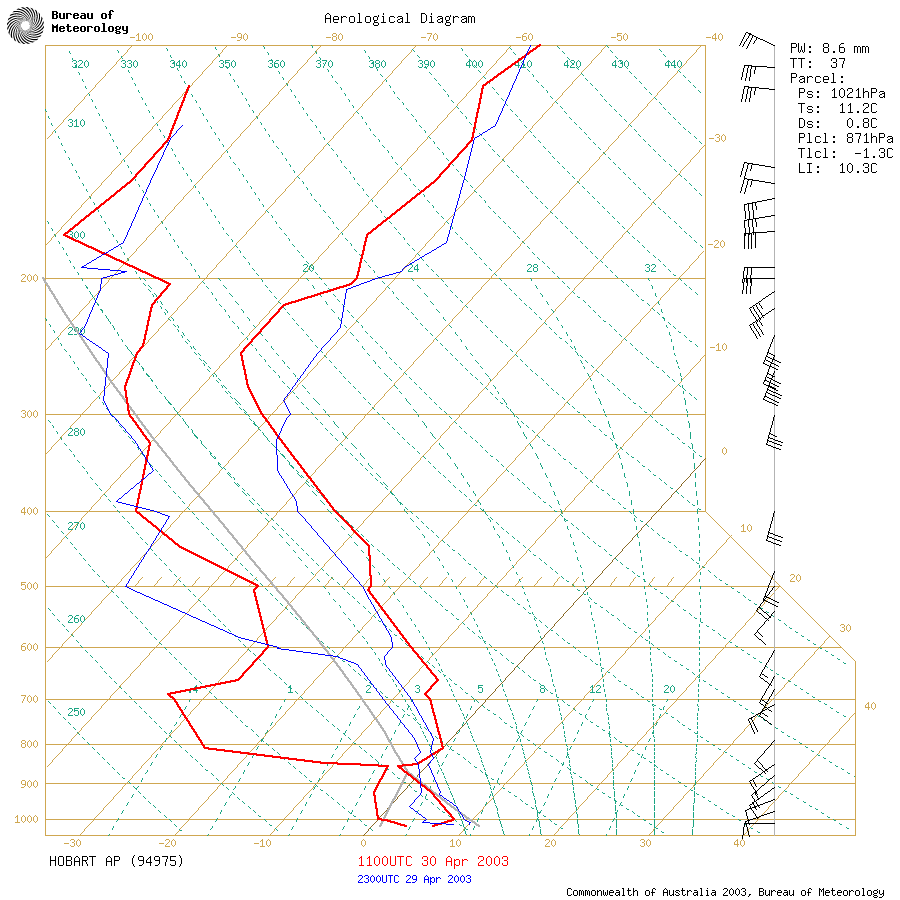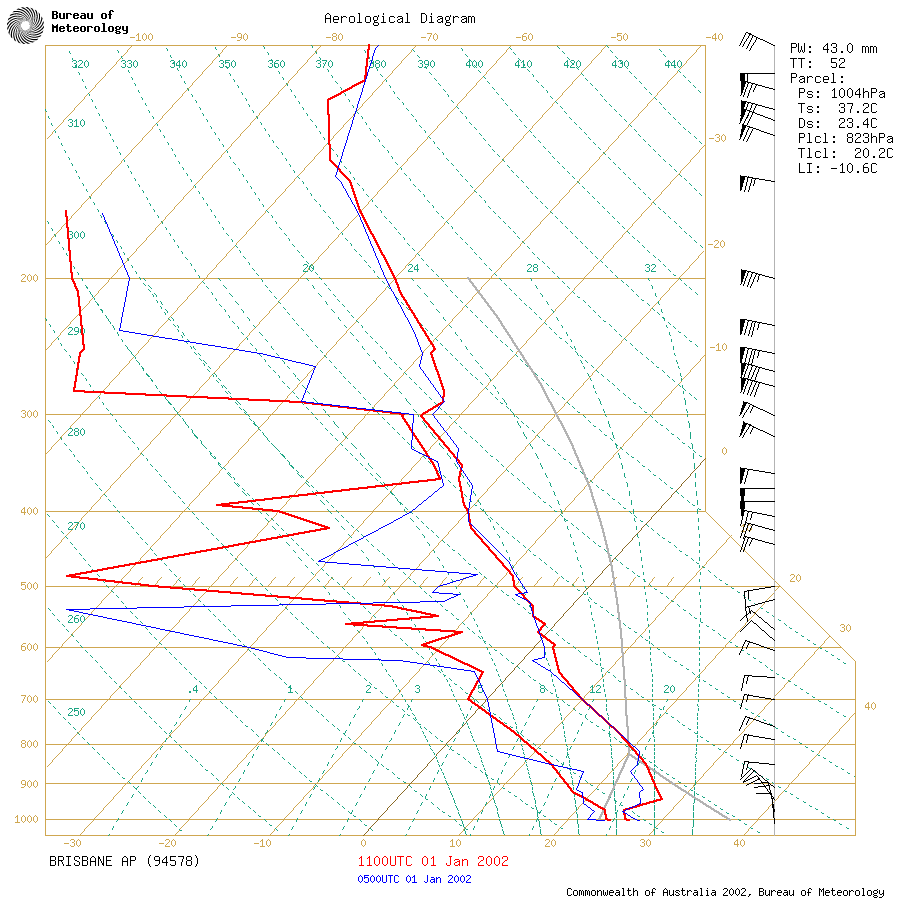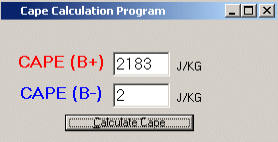| Notice that for the entire plot, the TAPP
equals, or exceeds that of the temperature line? Except for two areas,
there’s a very small cap near 800mb, and at the top of the Skew-T (around
13,200m) the air parcel line crosses to be on the left of the ELR.
The cap is so small though, that it will not make a difference – considering
the uneven surface heating, you can almost bet that there would be areas
with convection well above this level.
A cap is considered as a ‘lid’ on convection.
A cap is an area where the TAPP crosses to the left of the ELR, and then
eventually crosses back to the right of the ELR. So in between, you’ll
have an area of stability that suppresses convection. A cap is not
to be confused with an inversion, which is simply a descriptive term on
what the ELR does, it has nothing to do with the TAPP. However, because
of an inversion’s properties, a cap often occurs near, or on an inversion.
This is a reason why these two terms are often confused to have analogous
meanings.
This may now become a little confusing, as
if the cap is a stable layer, and the particular sounding used in this
example is a representation of a completely unstable atmosphere, how is
the atmosphere completely unstable? There’s are few other things
that must be noted when looking at instability. The larger the difference
between the TAPP and the ELR, then the stronger the stability, or instability
is in that area. For example, if a parcel of air is 5C warmer than
its surroundings, it’ll ascend faster than air that is 2C warmer than its
surroundings. Here's what I mean:
 
Both of these parts of the atmosphere are unstable,
but the one on the right is more unstable than the left. That can
be seen even just looking at the LIs. -4 LIs on the first sounding
vs -9 LIs on the second sounding.
Similarly, if air is 5C colder than its surroundings,
it’ll descend OR reduce speed faster than a parcel of air 2C colder.
As air rises, it gains momentum, updrafts can often gain speed very quickly,
reaching 40-60km/h and sometimes as high as 150km/h. When an updraft,
or a parcel of air that is ascending reaches a stable layer (eg, a cap),
it begins to slow down, but it doesn’t stop immediately. A useful
analogy that can be used, is the example of a ball rolling down a hill.
The steep the decline (the warmer the parcel of air is to its surroundings),
the faster the ball will roll down the hill (the faster the parcel of air
will ascend). The opposite can occur when a ball rolling down a slope,
reaches an incline. What happens when a ball rolling down a slope
suddenly reaches an incline? Will it stop immediately? It certainly
will not! It’ll roll up the incline and slow down. The steeper
the incline, the faster the ball will slow down (the faster a parcel of
air will reduce its speed), and if a ball is placed at the bottom of an
incline, it simply won’t move at all (a parcel of air will not ascend,
therefore is stable).
The small cap that can be seen on the sounding
will easily be ‘broken’ from the momentum of air gained from below it,
where it’s slightly unstable. Basically, this stable layer is so
negligible, that in our rolling ball example, this will be seen as a very
small incline on a declining slope. The ball would have been given
an opportunity to already gain speed, and will slow down at the incline,
but still proceed over the incline, and will travel down the rest of the
slope without hinderence. Similarly, our parcel of air that is rising
in the atmosphere that this skew-T represents will see this cap as a small
hindrance, and will slow down at this point, and continue rising. For this
reason, small caps in the lower atmosphere are easily broken – often without
any other assistance. Now you can understand why before, the cap
mentioned in the Skew-T could easily be broken, as the air gathered momentum,
it was able to break such a small cap. Anything under 0.5C can easily
be broken by this method.
Here is a good place to introduce CAPE, (Convective
Available Potential Energy). CAPE is, as the name suggests, the amount
of available convective potential energy in the atmosphere. Crudely,
but simply – it is the measure of the area between the air parcel line
and the ELR where the air parcel is to the right of the ELR. The
larger the CAPE, the more unstable the atmosphere is. Air will rise
faster if it is significantly warmer then its surroundings, this results
in stronger, and more sustained updrafts. With CAPE being a measure
of this instability, it is fairly explanatory why large CAPE’s often correspond
with severe thunderstorm development.
Think of CAPE this way in regards to the atmosphere.
If CAPE is simply a measure of the amount of area that the air parcel line
lies to the right of the ELR, then the larger the CAPE the larger the temperature
differences between these two lines. Time for some more examples,
lets look at two soundings - both having large areas of instability, but
one being more unstable than the other. |











